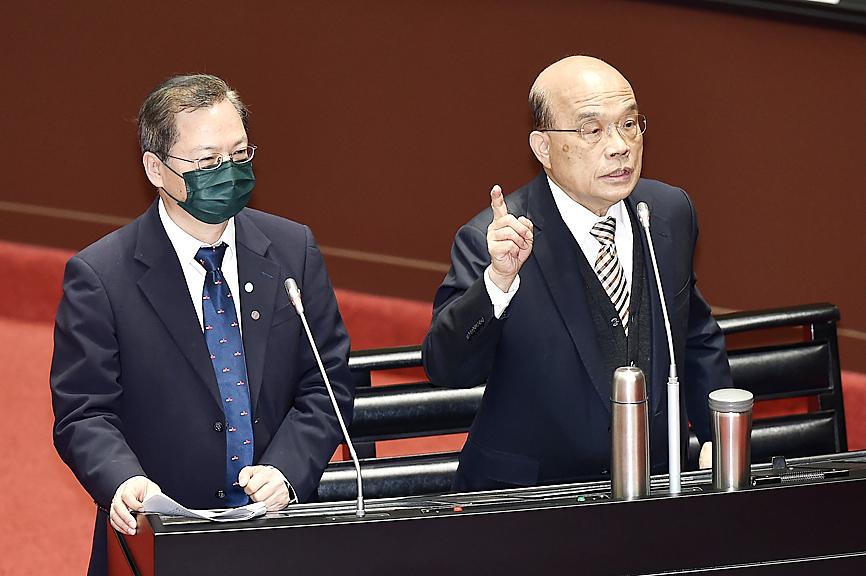The government has allocated NT$608 billion (US$21.35 billion) to spend on public infrastructure this year, in a bid to stimulate the economy amid the COVID-19 pandemic, the National Development Council (NDC) said on Monday.
While Taiwan’s response to COVID-19 has been largely successful, some industries have been hit hard by the pandemic, which has prompted the government to invest heavily in infrastructure as a way of increasing employment, NDC Minister Kung Ming-hsin (龔明鑫) said.
The annual public infrastructure allocation, which has exceeded NT$600 billion for the first time, would fund projects such as the Taoyuan Aerotropolis (桃園航空城), the acquisition of new trains by the Taiwan Railways Administration, the installation of air-conditioners in public schools, and the improvement of water collection and supply systems, the council said.

Photo: Tu Chien-jung, Taipei Times
Regarding the Taoyuan Aerotropolis project, more than NT$60 billion would be allocated in September for the acquisition of land, the council said.
The 4,500 hectare project, near Taiwan Taoyuan International Airport, is to be a modern industrial logistics center, development zone and urban residential area.
In the first two months of this year, government public works spending was NT$54.6 billion, an increase of NT$3.5 billion from last year, but it accounted for only 8.98 percent of the total allocation for the year, Kung said.
Government agencies are being urged to expedite work on infrastructure projects, he added.

COMPETITION: AMD, Intel and Qualcomm are unveiling new laptop and desktop parts in Las Vegas, arguing their technologies provide the best performance for AI workloads Advanced Micro Devices Inc (AMD), the second-biggest maker of computer processors, said its chips are to be used by Dell Technologies Inc for the first time in PCs sold to businesses. The chipmaker unveiled new processors it says would make AMD-based PCs the best at running artificial intelligence (AI) software. Dell has decided to use the chips in some of its computers aimed at business customers, AMD executives said at CES in Las Vegas on Monday. Dell’s embrace of AMD for corporate PCs — it already uses the chipmaker for consumer devices — is another blow for Intel Corp as the company

MediaTek Inc (聯發科) yesterday said it is teaming up with Nvidia Corp to develop a new chip for artificial intelligence (AI) supercomputers that uses architecture licensed from Arm Holdings PLC. The new product is targeting AI researchers, data scientists and students rather than the mass PC market, the company said. The announcement comes as MediaTek makes efforts to add AI capabilities to its Dimensity chips for smartphones and tablets, Genio family for the Internet of Things devices, Pentonic series of smart TVs, Kompanio line of Arm-based Chromebooks, along with the Dimensity auto platform for vehicles. MeidaTek, the world’s largest chip designer for smartphones

TECH PULL: Electronics heavyweights also attracted strong buying ahead of the CES, analysts said. Meanwhile, Asian markets were mixed amid Trump’s incoming presidency Taiwan Semiconductor Manufacturing Co (TSMC, 台積電) shares yesterday closed at a new high in the wake of a rally among tech stocks on Wall Street on Friday, moving the TAIEX sharply higher by more than 600 points. TSMC, the most heavily weighted stock in the TAIEX, rose 4.65 percent to close at a new high of NT$1,125, boosting its market value to NT$29.17 trillion (US$888 billion) and contributing about 400 points to the TAIEX’s rise. The TAIEX ended up 639.41 points, or 2.79 percent, at 23,547.71. Turnover totaled NT$406.478 billion, Taiwan Stock Exchange data showed. The surge in TSMC follows a positive performance

FUTURE TECH: Nvidia CEO Jensen Huang would give the keynote speech at this year’s Consumer Electronics Show, which is also expected to highlight autonomous vehicles Gadgets, robots and vehicles imbued with artificial intelligence (AI) would once again vie for attention at the Consumer Electronics Show (CES) this week, as vendors behind the scenes would seek ways to deal with tariffs threatened by US president-elect Donald Trump. The annual Consumer Electronics Show opens formally in Las Vegas tomorrow, but preceding days are packed with product announcements. AI would be a major theme of the show, along with autonomous vehicles ranging from tractors and boats to lawn mowers and golf club trollies. “Everybody is going to be talking about AI,” Creative Strategies Inc analyst Carolina Milanesi said. “From fridges to ovens